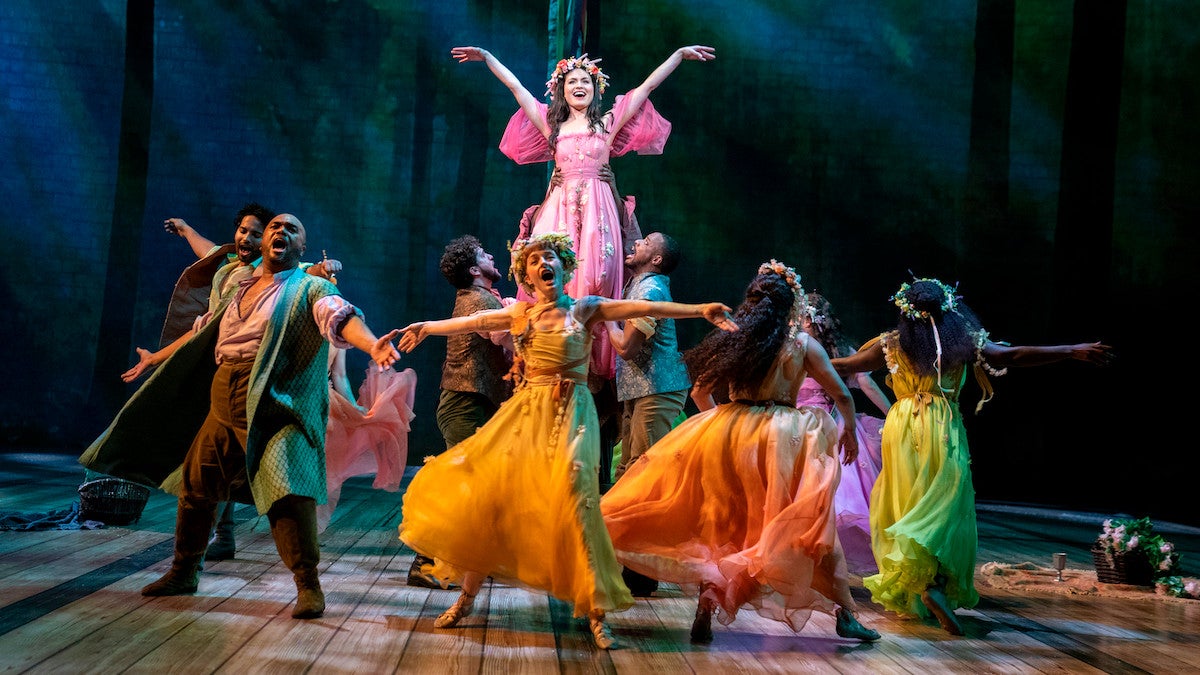
Merlyn and his magic tricks aren’t the only things that Aaron Sorkin cuts in his revival of Alan Jay Lerner’s book for the 1960 musical “Camelot.” Gone, too, is almost any sense of romance. This new incarnation of the classic but problematic tuner by Lerner and Frederick Loewe opened Thursday at LCT’s Vivian Beaumont Theater.
Upon once a time, Lerner’s book and lyrics for Loewe’s music told not one but two love stories. There was Guenevere, the reluctant princess who unknowingly falls in love with the king after a meet cute in the forest where Arthur is disguised as a commoner. And there was Guenevere, the queen who reluctantly falls in love with the dashing knight Sir Lancelot after butting heads with him repeatedly throughout Act 1. In Sorkin’s version, Guenevere (Phillipa Soo) is far too independent and liberated to fall in love with anybody. At the musical’s tragic conclusion, King Arthur (Andrew Burnap) now tells his queen that he has always loved her “for what it’s worth.” Guenevere, taken aback by the king’s casual use of the prepositional clause, admits that she has always loved him, too.
For what it’s worth, all this talk of love in the final scene came as news to me. For the preceding three hours, Guenevere had been so busy being a rebel that it wasn’t even a good bet she liked Arthur, much less loved him. And Guenevere was so pissed off at Arthur for siring an illegitimate child, Mordred (Taylor Trensch), that she finally bedded Lancelot (Jordan Donica) more out of spite than love.
Lerner’s book, based on T. H. White’s “The Once and Future King,” tells the story of a woman who admires one man as much as she loves him and lusts for another man as much as she loves him. Guenevere’s love for both men is never in doubt, not in the clunky 1967 “Camelot” movie starring Vanessa Redgrave or the embalmed “Camelot” revival starring Richard Burton (the original King Arthur) that I saw at Lincoln Center in 1980.
In the beginning, Sorkin’s new and spunky Guenevere is fun to watch, since it represents a major step forward artistically for Soo, who has always tended to be a little wan in her stage performances. Soo immediately emerges as defiant, and she is deliciously devious in getting what she wants with the beautifully sung “Take Me to the Fair,” by far this production’s most engaging scene. But between her sly seduction of three smitten knights and her initial escape into Arthur’s arms in the forest when she is determined not to marry the king, how much independence can one heroine flaunt without extinguishing any spark of romance?
In the original “Camelot,” after Lancelot kills Sir Lionel in a jousting contest and promptly brings him back to life, the arrogant French knight finally wins the admiration and love of Guenevere. In Sorkin’s “Camelot,” King Arthur partakes in that third match — and it is he who is “killed” and resurrected by Lancelot. Or as the king keeps telling anyone who will listen, “I wasn’t dead. I was unconscious.”
The more Arthur repeats the line the funnier it becomes. It also turns Arthur into something of a wimp. Lancelot has always been the alpha male of “Camelot,” but does that mean Arthur must be reduced to the omega male? In interviews, Sorkin has been quoted as saying he originally wanted to cut Arthur’s song “How to Handle a Woman.” Instead, he has trimmed it radically, even though the song more than ever goes straight to what’s wrong with the marriage between this particular king and queen.
Burnap delivers an extremely young Arthur, and he is amusingly conflicted in his many debates (too many debates, actually) with himself about honor and justice. The problem is, he never grows up to be a king in Act 2. It reminds me of that old debate regarding “Mr. Smith Goes to Washington”: Jimmy Stewart’s senator is so well-meaning but naïve that the government might be better off if the corrupt but competent politicians keep control.
Donica’s Lancelot is the male-stud prop who is trotted out in the second act to sing the song everyone wants to hear when you go to see “Camelot.” When he finishes his passionate delivery of “If Ever I Would Leave You,” it’s a surprise that Soo doesn’t ask him for a cigarette to light up.
Barlett Sher has directed definitive productions of “South Pacific,” “The King and I” and “My Fair Lady” at Lincoln Center Theater. Across the plaza, he has had much less success with unfocused productions of operas as varied as “Otello” and “The Tales of Hoffmann.” Those directorial assignments at the Met Opera show up in this “Camelot.” The grandeur of Arthur and Guenevere meeting in the forest is reminiscent of the Fountainebleau scene in Verdi’s “Don Carlo” where the prince and Elizabeth (another French emigree) also meet by chance. The vaulted, massive set design by Michael Yeargan (yet another Met Opera veteran) replicates that wintery moment, and for a while, it appears that this “Camelot” will take an intriguing detour to tell us what would have happen if Elizabeth had married Don Carlo and not ended up with his father, Philip, instead.
Sher’s direction is also a marvel when Sorkin’s book is at its messiest. Morgan Le Fey used to be Mordred’s aunt. Now, she is not only his mother (Camden McKinnon), she is also the major reason Guenevere stages a hissy fit over Arthur’s renewed contact with his old girlfriend. All of this pent-up sexual resentment is played out concurrently with Guenevere and Lancelot’s affair, because it is Arthur’s trip to see Morgan Le Fey to make amends that the two lovers are left alone to commit treason. Sher handles the dueling stories magnificently, but in the end, all the cross-cutting only emphasizes the subtext for Guenevere’s sleeping with Lancelot: It’s her revenge on Arthur. Love has nothing to do with it.
Much has been made of Sorkin getting rid of Merlyn (Dakin Matthews) after a brief scene and cutting all the magic tricks from “Camelot.” The result is that only one song has been lost. It’s when the enchantress Nimue sings “Follow Me” early in the first act. Otherwise, the score has been left pretty much intact. The original Lerner and Loewe score is why writers keep tinkering with the problematic book, but I’m not so sure that many of those songs aren’t part of the problem. “The Seven Deadly Virtues,” “Fie on Goodness” and “Guenevere” continue to cast a stodgy pall of second-rate operetta over the entire second act.
Once again, Lincoln Center Theater shows that it knows how to amplify a musical. The real singing voices and the real playing of 30 musicians in the pit can be heard. Marc Salzberg and Beth Lake’s sound design merely supports the music; it doesn’t replace the original sound. It’s ironic because when the Vivian Beaumont opened in 1965, the venue was lambasted as the acoustic nightmare of Broadway theaters. Today, it is the last refuge of experiencing Broadway musicals as they were meant to be heard.
















